Unlike many animals, it is human nature to look not only under the legs and forward, but also upward, which means that aesthetics should be inherent in the decoration not only of the floor and walls, but also of the ceiling. If in most rooms the main requirement for ceiling material is often visual appeal, then in the kitchen other factors, such as durability, resistance to steam, the ease of cleaning from dirt and so on, are of great importance. Since all this does not negate the fact that the surface should remain beautiful, the improvement of the ceiling must be approached with special care.

Kinds
Most people will not be able to give an extensive answer to the question of how to finish the kitchen ceiling - it just so happened that many of the materials convenient for this place in other rooms are rarely used. Nevertheless, it would also be a big mistake to assume that your choice is very limited - in fact, you have a lot of options, and now you will see for yourself.
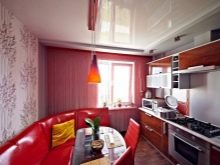
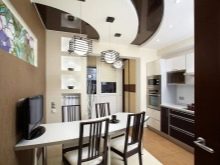

Whitewash
The simplest, yet "old-fashioned" way of decorating the ceiling in any room is its whitewashing. In terms of financial costs, such repairs will cost a mere penny, because the finishing materials in this case are just chalk or lime, diluted in water. The liquid composition of dry material is usually made by the owner himself, he also puts the mass on the surface, and then it remains only to wait until everything dries and takes its final form.



In the kitchen, such a ceiling is appropriate if only because it is 100 percent environmentally friendly, and you can at any time make a decision regarding the restoration procedures. Contrary to popular belief, modern whitewashing need not be white. - no one bothers to add color to the composition, as is done with some types of modern paints. Whitewashing in combination with beams provides the maximum believability of a rustic style.



Of course, this approach also has drawbacks - for example, the complete inability of whitewashing to hide surface defects. Therefore, before performing the procedure, you will have to spend time and effort on preparatory work, which includes removing the old coating, and with it dirt and dust, as well as filling up irregularities. Besides, lime does not allow even the thought of washing, because in principle it is afraid of moistureand regular surface contamination that is unavoidable in a kitchen will force you to update your ceiling over and over again.


Painting
In a sense, painting resembles whitewashing, but at the same time it is better at least in terms of durability and readiness for washing. As with lime, the owner himself most often deals with direct application to the surface, but the mixture is sold ready-made, and the maximum that is needed is to buy a color of a certain color, having decided on its proportion.
Among other things, the texture of the paint is much denser than that of lime for whitewashing, because the painted surface looks neater, it does not show the characteristic flows and stains.



But still, let's not praise this material - although it allows washing, the constant humidity and intense friction with detergents will quickly “kill” such a finish, even if it can withstand a little longer. Besides, you will not be able to avoid the necessary preliminary preparation of the surface - in any case, it is necessary to level the ceiling with a sandpaper, cover the cracks, remove all dust and dirt. The old layer of paint is usually impossible to remove, and this is not a problem if the hiding power of the new is high enough.
However, the brightest spots have to be painted over repeatedly so that they do not shine through the new repair.


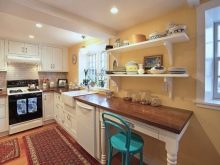
Polystyrene foam tile
Not so long ago, such a solution was a rage (not for the kitchen, but in principle for the premises), however, in recent years such material has lost its relevance. Figuratively speaking, this is a stucco molding for the poor - it is such a decoration that usually mimics polystyrene foambut, speaking objectively, I have to admit that the fact of fake and its indicative cheapness adversely affect the perception of the interior.
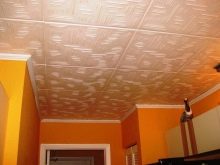


Expanded polystyrene can mask minor gaps, but in general this finishing option is completely unproductive to hide large bumps and protrusions - these will only be emphasized even more. The admissibility of washing does not save much, because the tile absorbs dirt and grease inside, and its relief structure is not too convenient for effective cleaning. Finally, this type of plastic is heavily criticized for burning, and it also releases very toxic substances during combustion.



For all its shortcomings, good-quality polystyrene tiles, which were not very economical, can be a good addition to a country style. In any case it is relatively inexpensive, which means it is considered by everyone who is looking for a way to make repairs budget. Convenience of mounting on special glue allows owners to refuse to pay for the services of a master, when gluing can be done on their own. At the same time, thick plates hide old bright spots better than the same whitewash or paint.
Having wished to renew the old finish, you can always paint or whiten the ceiling directly on top of the polystyrene without removing the old finish.



Stretch ceiling
And this is a squeak of fashion today.The stretch fabric can be either glossy or matte - the latter has universal compatibility with all styles, and the former goes well with brilliant art deco and hi-tech. Contrary to expectations this solution is acceptable even in kitchens with low main ceilings, because the tension level can differ by only a few centimeters.

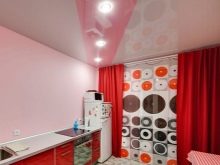

Variation of design is considered to be a big advantage of suspended ceilings, since the customer can choose any color or even a picture, order photo printing of any image and mount the lighting under the cover.
Installation of such a finish gives a perfectly flat surface without any preparatory work, and is also able to hide the communication.



Most often, a PVC film is used as the material, which is inexpensive and allows washing. Those who pursue an exclusive interior and are ready to spare no money often make a choice in favor of a more expensive stretch ceiling based on fabric.



Suspended ceiling
And here is another definite top of recent years, highly valued by most designers who are trying to fully reveal their capabilities. In fact, it is an aluminum frame on which drywall is attached, but instead of gypsum panels, plastic panels and a wooden lining can be used, and if desired, all this in the future can also be glued with wallpaper or sheathed with laminate.


A peculiar “feature” of suspended ceilings is that they combine well with other types of finishes, and also allow the creation of multi-level structures, which is convenient for zoning. Under the outer skin you can hide communications and lighting, and some owners order a full-fledged glass ceiling in the form of a stained-glass window. With other advantages, the installation is quite simple, and the traditional plasterboard paneling is both quite cheap and environmentally friendly.
This solution has only one minus, but it is crucial for residents of most apartment buildings: the hanging structure is too cumbersome for a small kitchenette, which also has a low ceiling. For this reason, this option is more appropriate either in spacious private cottages, or in a studio apartment.
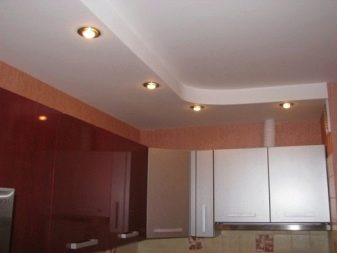

Rack ceiling
At its core, this kind of ceiling finish resembles the above-described suspended ceiling, only for covering the supporting frame, not arbitrary sheets, but slats are used - fragments of considerable length and minimum width. As lining, wooden slats are used, less often - aluminum or plastic, from siding. The advantages and disadvantages resemble the same suspended ceiling, but it should be remembered that for the kitchen, the joints of the rack ceiling should be closed to prevent the entry of contaminants and steam.

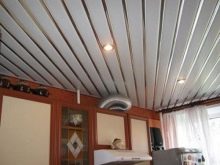

Cassette ceiling
This finish is often called a type-setting ceiling. In fact, this is also an analogy of the two types of ceiling described above, it only consists of the so-called cassettes - square plates of the same size, made of aluminum or galvanized metal, glass or chipboard. The size of such cartridges is usually quite large - standards start from 30 to 30 cm.

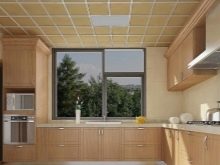

Decorative plaster
Such a ceiling rightly belongs to the number of expensive, elite. First of all, Venetian plaster (as this composition is otherwise called) can form bizarre patterns, but to create this it is worth attracting a proven professional. Besides, in terms of resistance to typical kitchen challenges, the Venetian is also very good - it is not afraid of moisture, while effectively protecting the surface underneath from the development of fungal colonies.


A feature of decorative plaster is that with its help today it is possible to imitate many other materials that could not so effectively stand in the right place and fill all the roughnesses of the substrate. Nonetheless the high cost of this material and the services of a master scare away many potential consumers.


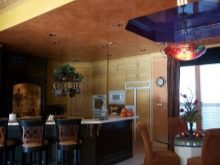
Color scheme
When deciding on the choice of color for the ceiling, it is necessary to focus not only on your own aesthetic preferences, but also on the stylistic features of the design of the entire kitchen, and the specifics of its lighting. The ceiling should not violate the selected gamut, competently fit into it and echoing something else, unless you have focused on photo printing.



For solid solutions, you should pay attention to the following popular options.
- The black. The decision stands out for its courage - people have long lost the habit of not being white in the ceiling, but here the exact opposite of whiteness. Such a daring move allows you to emphasize the lines of the interior and make it graphically attractive, but it is better not to experiment like this in rooms with a low ceiling.


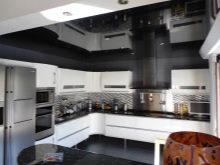
- White. On the one hand, nothing unusual, but on the other hand, since when did it become normal to refuse proven and successful ideas for the sake of pretentiousness. Achromatic white is combined with any other colors, and the whiteness of the ceiling, especially glossy, very much gives the kitchen space and light.



- Red. Another impudent trick, which is still rarely used, and therefore asks for the kitchen of this original. Psychologists say that bright warm tones in the kitchen are good for appetite and uplifting - excellent, no one said that you can’t trim the ceiling in this way.
It looks especially cool in a “wine” burgundy design and in roll call with accents on furniture.



- Brown. The wooden interior even in the plastic age remains one of the most popular because it is environmentally friendly and subconsciously associated with many people with home comfort. Moreover, the tree does not have to be natural - figuratively speaking, any imitation that conveys at least color is suitable. Taking it to the ceiling, you do not make it as gloomy as if it were black, but still effectively shade other, lighter tones.
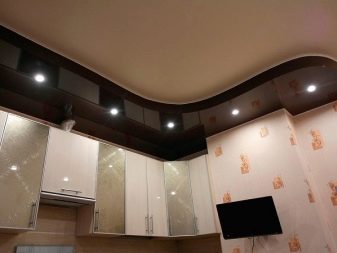

- Green. This ceiling color cannot be called the most popular, but in vain - the tone is unique, because it simultaneously calms, improves mood and improves appetite.
Having chosen a pleasant apple shade, you will make your kitchen in a special vibrant and vibrant way.



- Yellow and orange. These colors are traditionally associated with the sun and natural light, because their presence in the room, and even on the ceiling, looks quite reasonable. Such a choice is not for everyone, and by that he is good.



Theoretically, you can experiment with any color of a monophonic ceiling, if only its decoration does not look like a foreign body in the general image of the interior.
Design options
The design of the kitchen ceiling is not limited to just the choice of color - modern industrial capabilities allow you to freely experiment with the design of the ceiling. Even if you choose a plain surface, you have the right to decide whether it will be glossy or matte. Gloss gives shine, and in some cases it is able to provide almost a mirror image of everything that happens in the room. This decoration option is good in that it visually expands the room, adds brightness and lighting to it, but it’s important not to overdo it, because the abundance of blinding glare is unlikely to be a plus. Matte monophonic ceiling in this regard is more restrained, it brightens the room, but not excessively, and even has more opportunities to combine with one or another style of interior.



Many types of finishes allow not only monotony, but also the presence of patterns - they can be characteristic for stretch ceilings, and for surfaces glued with wallpaper or trimmed with Venetian plaster. The texture is appropriate in order to diversify the interior, and if you do not prefer minimalism or related areas, it will be quite appropriate.



The painting is an even more complex type of decoration of the ceiling surface, it is often done on fabric for stretch ceiling, but in some cases it is possible to involve the artist for improvement and other coatings. Unlike factory patterns, the painting is always individual and unique, and even minor mistakes in it can only emphasize the exclusivity and high cost of the interior.



Design with photo printing is appropriate for the same wallpaper, fabric and some other surfaces. When properly implemented in the overall profile of the interior, the result is breathtaking if you, sitting in a cozy and warm kitchen, see a pleasant summer sky with light clouds over your head all year round, even when winter and frost are outside. This, of course, is just a single example, but with the help of modern technologies you have the opportunity to transfer yourself to any place where you would like to dine.
It should be understood that the choice of suitable images for the ceiling is always somewhat less than for the walls.



How to choose?
Choosing a ceiling for a kitchen is actually not such a difficult task, and yet inexperienced owners regularly manage to spoil the impression of chasing something that they saw from their neighbors or on the Internet, but which is completely unsuitable for their apartment . In order not to do this at home, pay attention to simple and logically sound expert advice that will help you understand what your dream ceiling looks like.



- Practicality is at the forefront. When making repairs, most people focus on beauty, but in the kitchen, this factor does not play the first violin at all. Of course, it’s also worth taking care of the attractiveness of the interior, and saving your wallet will not hurt, but first of all, you need to put aside those options that do not meet the requirements for durability, ease of washing, and so on. Of course, you can consciously choose the same whitewash, being mentally prepared to change it at least once a year, but in practice there are not many such owners.
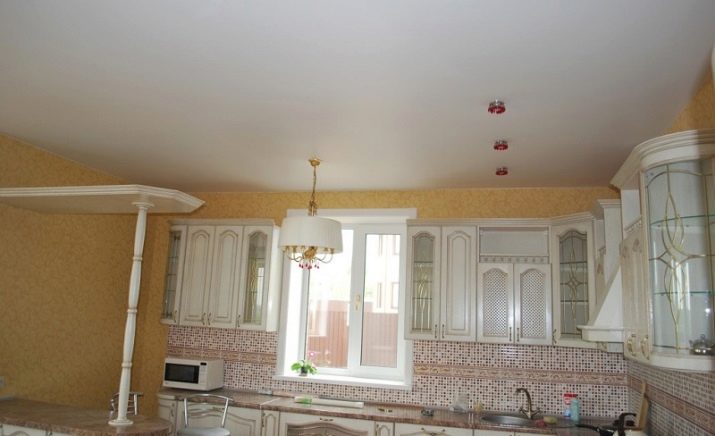
- The low ceiling needs to be trimmed with no frills and in bright colors. This is a reasonable idea, since you are directly interested in saving space - it’s a blessing that many modern styles are one way or another oriented towards minimalism. A combined multi-level ceiling can look beautiful, but not in a small kitchenette, where this bulky design will take up too much space, constraining (at least psychologically) its owners.

- The potential abundance of preparatory work encourages the choice of finishes, effectively hiding any irregularities. In many cases, the old surface is too damaged by defects, especially if you decided to remove the old one before installing the new coating. You can hide all these cracks, pits and protrusions with the help of diligent work with a spatula and a large amount of plaster, but in most cases it is much easier to spend a little more once by installing suspended, suspended, rack or cassette ceilings. A one-time overpayment in this case is fully justified, since the effect will be long-lasting.
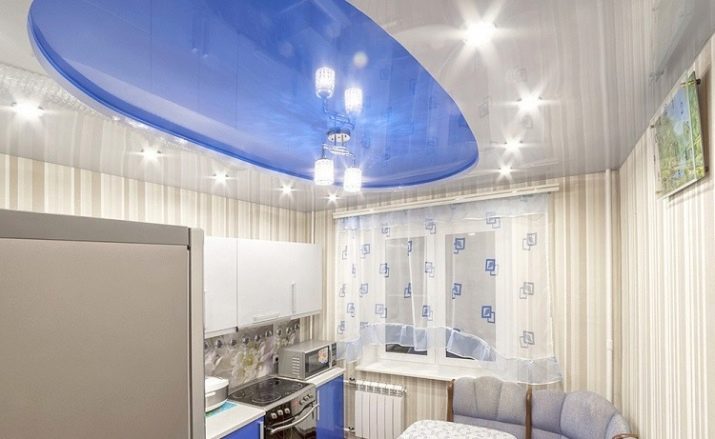
- Stylistic requirements must be met. In everyday life, not many people pay attention to this, but when overhauling a kitchen with replacing the ceiling, it makes sense to take care of the integrity of perception. From a moral point of view, you can understand that if you spent the predominant part of the money on the most modern equipment, then nothing was really left on the ceiling.But you are unlikely to argue that spoiling the ripening high-tech banal whitewash or painting. A reasonable approach involves pre-drafting a project with an estimate that takes into account all potential costs - so you will understand how to properly allocate finances.

Beautiful examples
The white ceiling is an eternally relevant idea that will always have a right to exist. In the first example, we see how this design option brightens the room - although there is no abundance of bright light sources, it still does not look dark at all, especially since the gloss additionally reflects the light. Due to the low main ceiling, the chandelier in this kitchen is inappropriate, because the designer “sewed” spotlights under the tension surface.
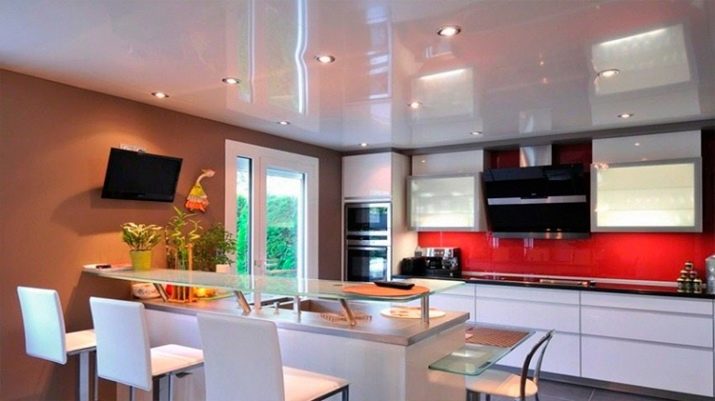
The black ceiling, and even glossy, is something completely original. On the one hand, due to the specifics of the shade, it absorbs light, while the gloss reflects it back, without limiting the space too hard. Against the backdrop of such a bold decision, a rather simple kitchen in terms of design suddenly acquires futuristic features and turns into a dream that cannot be forgotten.

You will not meet the kitchen in white and green colors so often, but in vain - just look at this lovely designer creation. The narrow and elongated shape of the room literally requires that the walls be light and expand the space, so the designer decided to put the main green on the ceiling, the walls of the headset, an apron and a picture, and it turned out worthy.

You can learn about the secrets of finishing the ceiling in the kitchen with plastic by watching the video below.










